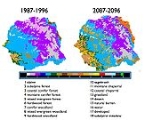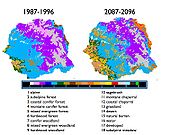
Dynamic global vegetation model
Encyclopedia
A dynamic global vegetation model (DGVM) is a computer program that simulates shifts in potential vegetation and its associated biogeochemical and hydrological cycles as a response to shifts in climate. DGVMs use time series of climate data and, given constraints of latitude, topography, and soil characteristics, simulate monthly or daily dynamics of ecosystem processes. DGVMs are used most often to simulate the effects of future climate change
on natural vegetation and its carbon and water cycles.
DGVMs generally combine biogeochemistry
, biogeography, and disturbance submodels. Disturbance is often limited to wildfires, but in principle could include any of: forest/land management decisions, windthrow, insect damage, ozone damage etc. DGVMs usually “spin up” their simulations from bare ground to "equilibrium" vegetation to establish realistic initial values for their various “pools”: carbon and nitrogen in live and dead vegetation, soil organic matter, etc corresponding to a documented historical vegetation cover.
DGVMs are usually run in a spatially distributed mode, with simulations carried out for thousands of “cells”, geographic points which are assumed to have homogeneous conditions within each cell. Simulations are carried out across a range of spatial scales, from global to landscape. Cells are usually arranged as lattice points; the distance between adjacent lattice points may be as coarse as a few degrees of latitude or longitude, or as fine as 30 arc-seconds. Simulations of the conterminous United States in the first DGVM comparison exercise (LPJ and MC1) called the VEMAP project in the 1990s used a lattice grain of one-half degree. Global simulations by the PIK group and collaborators using 6 different DGVMs (HYBRID, IBIS, LPJ, SDGVM, TRIFFID, and VECODE) used the same resolution as the general circulation model (GCM) that provided the climate data, 3.75 deg longitude x 2.5 deg latitude, a total of 1631 land grid cells. Sometimes lattice distances are specified in kilometers rather than angular measure, especially for finer grains, so a project like VEMAP is often referred to as 50 km grain.
 Several DGVMs appeared in the middle 1990s. The first was apparently IBIS (Foley et al., 1996), VECODE (Brovkin et al., 1997), followed by several others described below:
Several DGVMs appeared in the middle 1990s. The first was apparently IBIS (Foley et al., 1996), VECODE (Brovkin et al., 1997), followed by several others described below:
Several DGVMs have been developed by various research groups around the world:
The next generation of models - earth system models (ex. CCSM, ORCHIDEE, JULES, CTEM ) - now includes the important feedbacks from the biosphere to the atmosphere so that vegetation shifts and changes in the carbon and hydrological cycles affect the climate.
DGVMs commonly simulate a variety of plant and soil physiological processes. The processes simulated by various DGVMs are summarized in the table below.
Abbreviations are: NPP, net primary production; PFT, plant functional type; SAW, soil available water; LAI, leaf area index; I, solar radiation; T, air temperature; Wr, root zone water supply; PET, potential evapotranspiration; vegc, total live vegetation carbon.
Individual DGVMs usually incorporate the work of many people. Nevertheless, people who work in the field often associate with each DGVM the name of just one or just a few researchers. Listing these associations risks slighting the many hard-working but less visible contributors. To those who deserve to be on the list but are not, we apologize - and point out that anyone can edit entries in Wikipedia! Here's the list of some of the most well known DGVM modelers:
CASA and NASA-CASA - Chris Potter
CLM-DGVM -
HYBRID - Andrew Friend
IBIS - Jon Foley, Chris Kucharik, Univ. of Wisconsin
LPJ - Colin Prentice, Steven Sitch, Benjamin Smith, Wolfgang Cramer, Martin Sykes
MC1 - Jim Lenihan and Ron Neilson, U.S. Forest Service, Dominique Bachelet and Chris Daly, Oregon State University
SDGVM - Ian Woodward and Mark Lomas
TRIFFID - Peter Cox, Hadley Center
VECODE - Victor Brovkin, PIK
References:
Climate change
Climate change is a significant and lasting change in the statistical distribution of weather patterns over periods ranging from decades to millions of years. It may be a change in average weather conditions or the distribution of events around that average...
on natural vegetation and its carbon and water cycles.
DGVMs generally combine biogeochemistry
Biogeochemistry
Biogeochemistry is the scientific discipline that involves the study of the chemical, physical, geological, and biological processes and reactions that govern the composition of the natural environment...
, biogeography, and disturbance submodels. Disturbance is often limited to wildfires, but in principle could include any of: forest/land management decisions, windthrow, insect damage, ozone damage etc. DGVMs usually “spin up” their simulations from bare ground to "equilibrium" vegetation to establish realistic initial values for their various “pools”: carbon and nitrogen in live and dead vegetation, soil organic matter, etc corresponding to a documented historical vegetation cover.
DGVMs are usually run in a spatially distributed mode, with simulations carried out for thousands of “cells”, geographic points which are assumed to have homogeneous conditions within each cell. Simulations are carried out across a range of spatial scales, from global to landscape. Cells are usually arranged as lattice points; the distance between adjacent lattice points may be as coarse as a few degrees of latitude or longitude, or as fine as 30 arc-seconds. Simulations of the conterminous United States in the first DGVM comparison exercise (LPJ and MC1) called the VEMAP project in the 1990s used a lattice grain of one-half degree. Global simulations by the PIK group and collaborators using 6 different DGVMs (HYBRID, IBIS, LPJ, SDGVM, TRIFFID, and VECODE) used the same resolution as the general circulation model (GCM) that provided the climate data, 3.75 deg longitude x 2.5 deg latitude, a total of 1631 land grid cells. Sometimes lattice distances are specified in kilometers rather than angular measure, especially for finer grains, so a project like VEMAP is often referred to as 50 km grain.

Several DGVMs have been developed by various research groups around the world:
- LPJ - Germany, Sweden
- IBIS - Integrated Biosphere SimulatorIntegrated Biosphere SimulatorIBIS-2 is the version 2 of the land-surface model Integrated Biosphere Simulator , which includes several major improvements and additions to the prototype model developed by Foley et al. [1996]...
- U.S.
- MC1 - U.S.
- HYBRID - U.K.
- SDGVM - U.K.
- SEIB-DGVM - Japan
- TRIFFID - U.K.
- VECODE - Germany
- CLM-DVGM - U.S.
The next generation of models - earth system models (ex. CCSM, ORCHIDEE, JULES, CTEM ) - now includes the important feedbacks from the biosphere to the atmosphere so that vegetation shifts and changes in the carbon and hydrological cycles affect the climate.
DGVMs commonly simulate a variety of plant and soil physiological processes. The processes simulated by various DGVMs are summarized in the table below.
Abbreviations are: NPP, net primary production; PFT, plant functional type; SAW, soil available water; LAI, leaf area index; I, solar radiation; T, air temperature; Wr, root zone water supply; PET, potential evapotranspiration; vegc, total live vegetation carbon.
| process/attribute | formulation/value | DGVMs |
|---|---|---|
| shortest time step | 1 hour | IBIS |
| 2 hours | TRIFFID | |
| 12 hours | HYBRID | |
| 1 day | LPJ, SDGVM, SEIB-DGVM, MC1 fire submodel | |
| 1 month | MC1 except fire submodel | |
| 1 year | VECODE | |
| photosynthesis | Farquhar et al. (1980) | HYBRID |
| Farquhar et al. (1980) Collatz et al. (1992) |
IBIS, LPJ, SDGVM | |
| Collatz et al. (1991) Collatz et al. (1992) |
TRIFFID | |
| stomatal conductance | Jarvis (1976) Stewart (1988) |
HYBRID |
| Leuning (1995) | IBIS, SDGVM, SEIB-DGVM | |
| Haxeltine & Prentice (1996) | LPJ | |
| Cox et al. (1998) | TRIFFID | |
| production | forest NPP = f(PFT, vegc, T, SAW, P, ...) grass NPP = f(PFT, vegc, T, SAW, P, light competition, ...) |
MC1 |
| GPP = f(I, LAI, T, Wr, PET, CO2) | LPJ | |
| competition | for light, water, and N | MC1, HYBRID |
| for light and water | LPJ, IBIS, SDGVM, SEIB-DGVM | |
| Lotka-Volterra in fractional cover | TRIFFID | |
| Climate-dependent | VECODE | |
| establishment | All PFTs establish uniformly as small individuals | HYBRID |
| Climatically favored PFTs establish uniformly, as small individuals | SEIB-DGVM | |
| Climatically favored PFTs establish uniformly, as small LAI increment | IBIS | |
| Climatically favored PFTs establish in proportion to area available, as small individuals | LPJ, SDGVM | |
| Minimum 'seed' fraction for all PFTs | TRIFFID | |
| mortality | Dependent on carbon pools | HYBRID |
| Deterministic baseline, wind throw, fire, extreme temperatures | IBIS | |
| Deterministic baseline, self-thinning, carbon balance, fire, extreme temperatures | LPJ, SEIB-DGVM | |
| Carbon balance, wind throw, fire, extreme temperatures | SDGVM | |
| Prescribed disturbance rate for each PFT | TRIFFID | |
| Climate-dependent, based on carbon balance | VECODE | |
| Self-thinning, fire, extreme temperatures, drought | MC1 |
Individual DGVMs usually incorporate the work of many people. Nevertheless, people who work in the field often associate with each DGVM the name of just one or just a few researchers. Listing these associations risks slighting the many hard-working but less visible contributors. To those who deserve to be on the list but are not, we apologize - and point out that anyone can edit entries in Wikipedia! Here's the list of some of the most well known DGVM modelers:
CASA and NASA-CASA - Chris Potter
CLM-DGVM -
HYBRID - Andrew Friend
IBIS - Jon Foley, Chris Kucharik, Univ. of Wisconsin
LPJ - Colin Prentice, Steven Sitch, Benjamin Smith, Wolfgang Cramer, Martin Sykes
MC1 - Jim Lenihan and Ron Neilson, U.S. Forest Service, Dominique Bachelet and Chris Daly, Oregon State University
SDGVM - Ian Woodward and Mark Lomas
TRIFFID - Peter Cox, Hadley Center
VECODE - Victor Brovkin, PIK
References:

